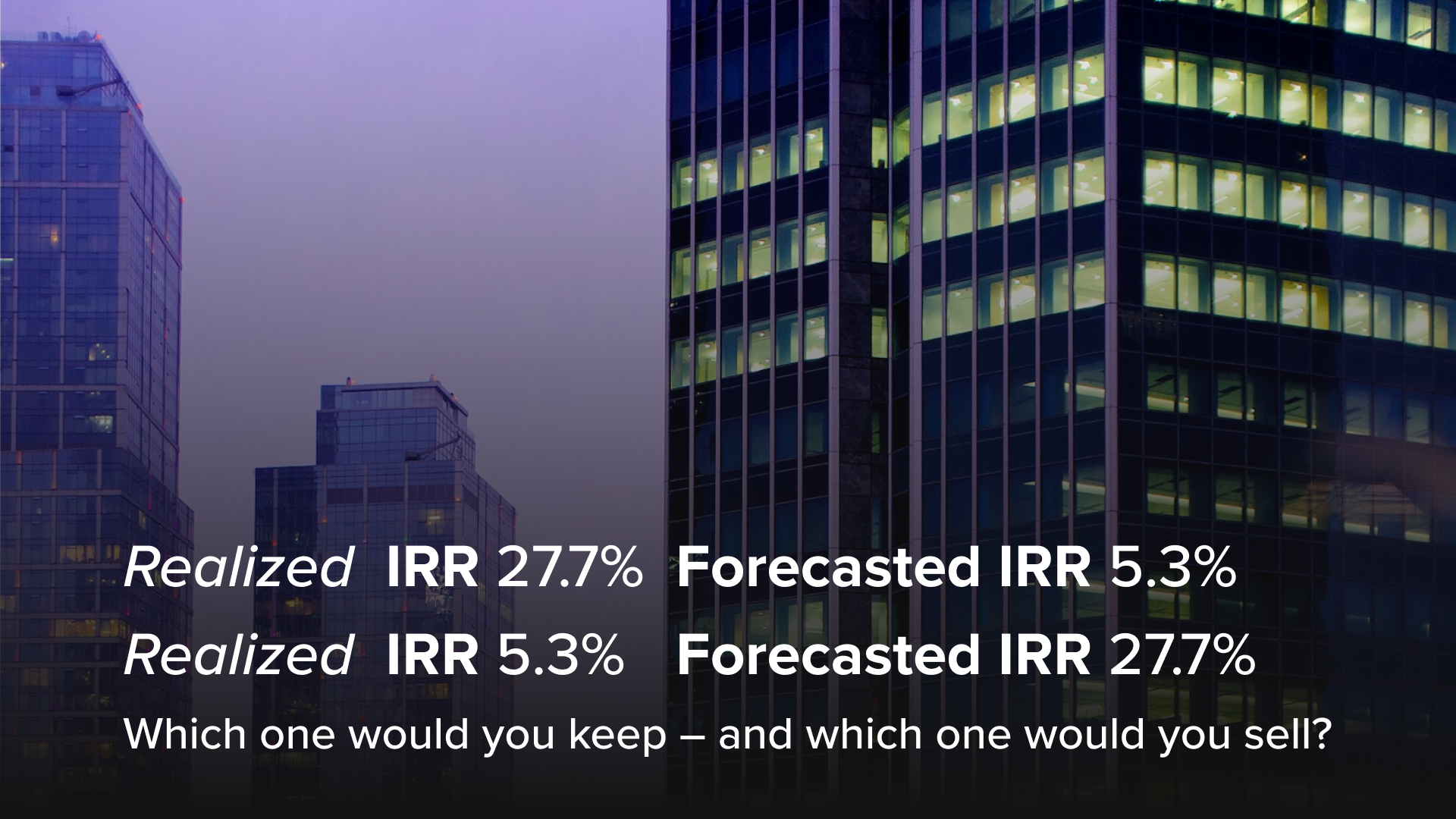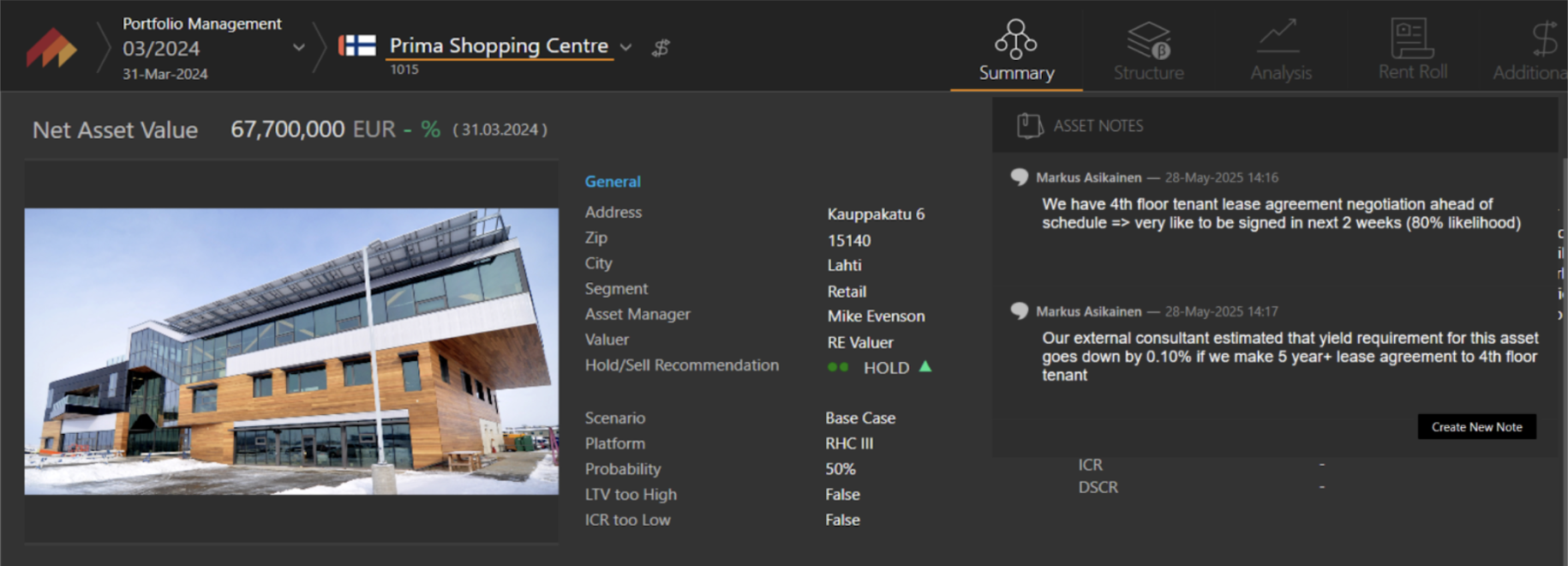


It’s tempting to hold on to the asset that’s performed well historically. A high realized IRR looks great in the next investor report, and makes a manager feel confident. But that instinct can be misleading.
Another trap? Holding large assets because they boost AUM-based fees for the manager, even when their upside is gone.
The smarter way to approach the hold/sell question is forward-looking, scenario-based, and grounded in real-time facts from the ground. In this post, we break down the most common pitfalls and how to make better-informed decisions, even when the answer isn’t obvious.
Investors love strong track records, but a 27.7% realized IRR doesn’t guarantee future returns. In fact, the opposite is often true: high realized returns may signal that the asset has already delivered its value, and that future IRR will be much lower.
Decisions should be based on forecasted IRR i.e. what the asset is expected to return from today onward, based on current market conditions, tenant outlook, and business plan status.

Yes, forecasted IRR involves assumptions. But it’s not guesswork if done right. It becomes a powerful decision tool when based on:

This kind of analysis helps you see beyond a single number. It quantifies uncertainty and forces the team to discuss how likely each scenario actually is, and what can be done to increase the likelihood of the upside scenarios and decrease the likelihood of the downside scenarios.

The real job of an asset manager isn’t just building the scenarios but updating them constantly as new information comes in. That’s what makes the forecast reliable.
Real-world shift example:
Tip: Forecast inputs come from the ground —> decisions come from the top
Scenario probabilities aren’t created in isolation. They’re informed by leasing managers, property managers, and asset managers — the people closest to tenant talks, project risks, and market changes.
But the hold/sell decision is made by fund managers or directors.
ModelTree helps bridge this gap, making real-time scenario thinking visible across all levels.

Selling isn’t free. Broker fees, taxes, and legal costs can easily total 2% of the property value and you might also pay similar costs when buying the next property.
It’s natural to wonder: If I pay these costs, will I still come out ahead?
Let’s run the numbers:
€8.00M × (1.075)^5 ≈ €11.49M in 5 years
€7.84M × (1.09)^5 ≈ €12.06M in 5 years
Even after losing €160k in sales transaction costs, selling and reinvesting produces €0.58M more capital after 5 years.
The higher return on the new property (9% vs. 7.5%) compounds over time and outweighs the one-off cost of selling.
Investable proceeds = €7.84M × 0.98 = €7.6832M
Future value = €7.6832M × (1.09)^5 = €11.82M
Still ahead vs. hold (€11.49M) by €0.34M.
Even when the numbers mathematically clearly suggest a sale, managers often hesitate. Not because they don’t understand the theory but because of a deeper, more human bias:
“If I do nothing, I can’t be blamed for a bad decision.”
Inaction feels safer than action. Selling a property and getting it wrong, even with solid reasoning, can draw scrutiny. Holding and letting performance quietly decline rarely makes headlines. In some organizations, not transacting feels like not making a mistake.
There’s an old saying:
"A civil servant makes no mistake if they do nothing at all."
But in real estate portfolio management, this mindset can be costly. If the downside scenario has a 30% probability, then one in three times, that outcome is expected. That’s not failure but that’s normal risk. There's nothing wrong with taking action that sometimes leads to downside as long as it's based on the best available data.
The key is to actively manage the probabilities. Day-to-day asset management should aim to shift the odds in your favor: secure leases, negotiate well, and make decisions that strengthen the probability of the upside case while reducing the probability of the downside case.
Passive decision-making ties up capital in the wrong assets, eroding long-term returns. The best managers acknowledge the emotional comfort of inaction and choose action when the data justifies it.
The best managers aren’t just data-driven – they’re dynamic. They update assumptions as the ground shifts, look beyond past performance, and make disciplined choices with capital.
ModelTree helps turn that mindset into action by connecting ground-level intelligence to top-level decisions, with live scenario modeling that supports both conviction and agility.
Read more

Read more

Read more

Read more

We'll discuss your key challenges and demonstrate how our solutions can improve your workflows and help you make better real estate investment decisions.
Automate cash flow modeling
Run scenario simulations
Perform property valuations
Generate insightful reports